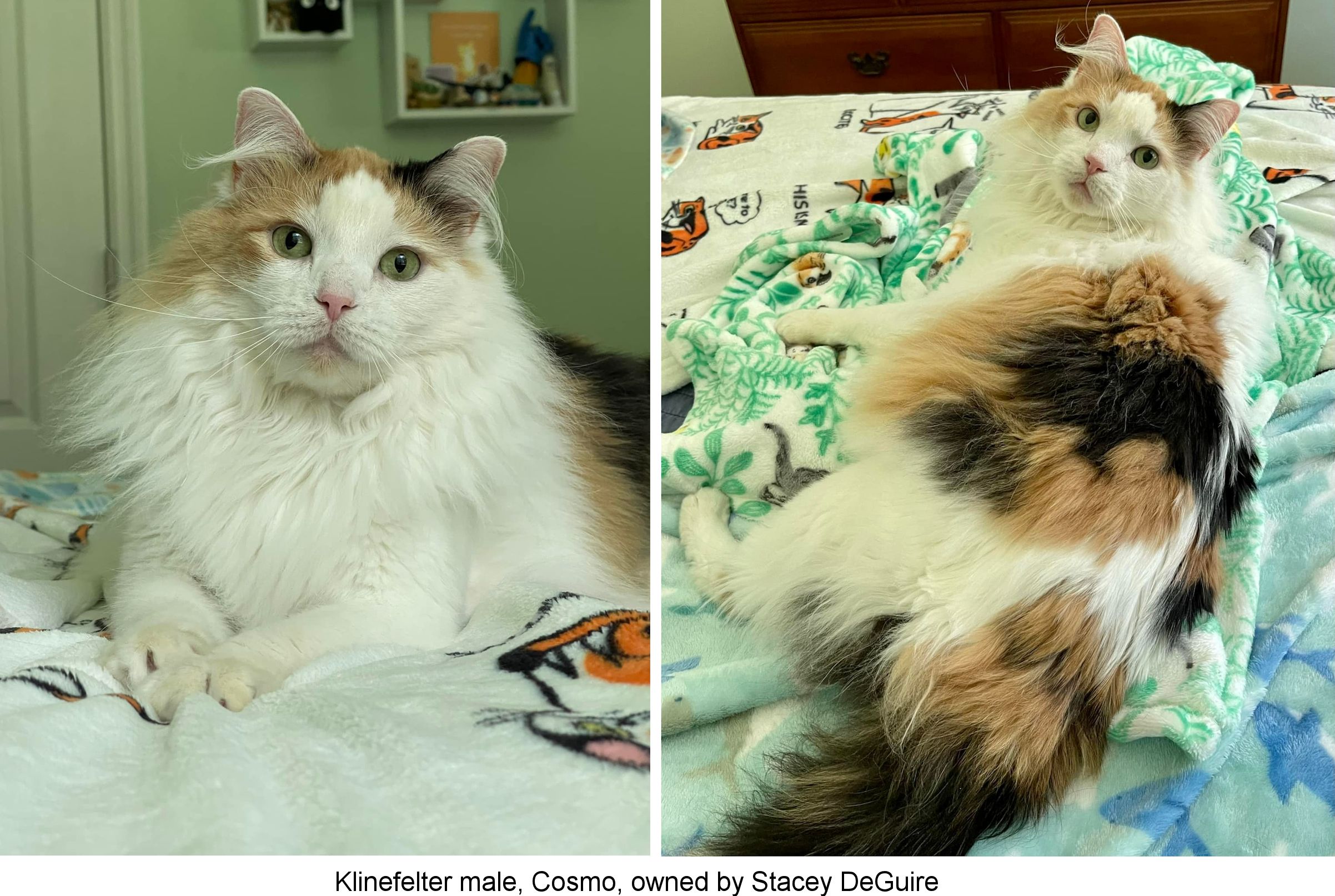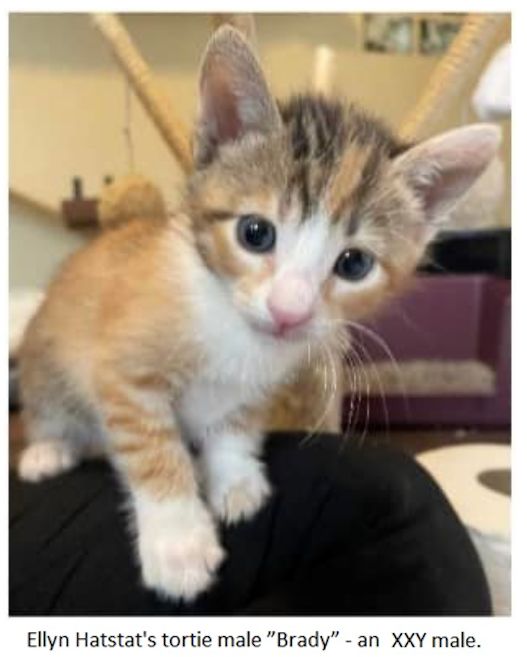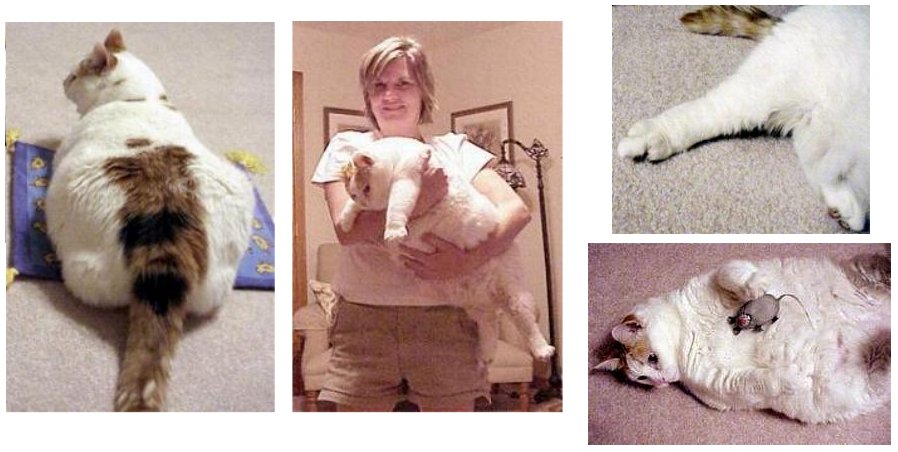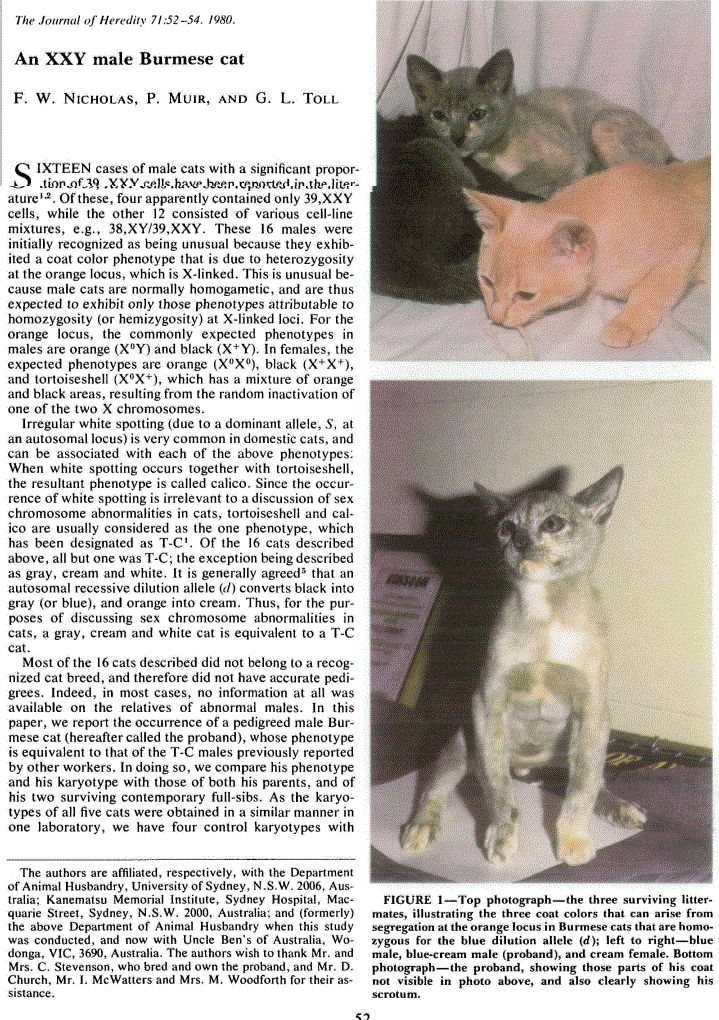
KLINEFELTER TORTIE MALES
Normal male cats only inherit one X chromosome so this is active in all skin cells as there is nothing equivalent on the Y chromosome which could "switch off" the O gene. More rarely there are male cats with XXY genetic make-up (equivalent to human Klinefelter's syndrome). They develop into males because they have a Y chromosome. However, just like XX females, they undergo X-inactivation and are genetically mosaics. If only one of those X chromosomes carries the O gene, this can result in a tortoiseshell tomcat.
According to Roy Robinson's 'Genetics for Cat Breeders' out of 125 kittens produced by black female x orange male there was 1 tortoiseshell male. The majority of calico or tortoiseshell males studied were from tortoiseshell/calico females and were either XXY (Klinefelter) or XXXY (chimera) genetic make-up. Further studies in the early 2000s on the chromosome complement and histology (structure) of tortoiseshell males in the UK and USA indicated around 0.43% of chromosomally abnormal (XY/XY, XX/XY or XXY) tortoiseshell male cats in the UK and 0.033% in the USA.
Klinefelter males are usually been found to be sterile and their tissues may be a mixture of XX and XY cells, XX and XXY cells or XY and XXY cells! If some of the "normal" XY tissue occurs in the testes, then the cat might even be fertile although the colour of the offspring he sires depend on whether the X gene in the cells that formed the testes have the O gene or not. Klinefelter Syndrome occurs in many species including cats. An XXY Amur (Siberian) tiger has also been reported.
Rachel E Gibson wrote in 1997 of a male calico that only mated with a very sexually aggressive females and which aligned himself with the females more than the males. The other males treated him like a female so he may not have many male hormones. His behaviour corresponded with the theory of the time that XXY tortie tomcats were feminine in their behaviour. Boo, another calico male, was believed to be sexually confused because of his extra chromosome. He attempted to mate with both females and males and also tried to nurse kittens or carry them around like a mother cat. Boo continued to spray after being neutered and was described as somewhat fat, not uncommon in XXY cats.
In 1997, T Lehmann reported a calico male which was red, white, black and grey. The genetic explanation he was given was that male calicos were an anomaly resulting from a failure during meiosis (cell division which creates eggs and sperm) called non-disjuncture. The chromosome of a particular pair fails to separate so that the female donates 2 X chromosomes instead of only one X. If the XX egg is fertilised by a Y sperm it (usually!) produces a physically male animal. Nowadays a red, white, black and grey cat would most likely be explained as a chimera (fused embryos).
Another tortie male, Koonikki Feirfiz Geezabird (Geezer), had intersex traits - testicular tissue in the position of an ovary plus one normally descended testicle. Geezer reportedly had both male and female behaviour and the vet believed him to be XXY. He solicited other males to mate him, but he also attempted to mate females. His father sired another tortie male (tortie tabby from a brown tabby female) so it was possible the father produced aberrant XY sperm.
Another Klinefelter tortoiseshell male is Simba von Schindetal an apparently solid red Maine Coon stud who failed to impregnate proven fertile females in 1988. Blood samples sent to a veterinary college in Giessen showed he had a mix of XY and XXY cells. A detailed physical examination of Simba found a small black spot on his left ear and a few black hairs sprinkled in his fur. These were originally thought to be harmless somatic mutations.
Susan Sanderlin-Berry had an XXY male tortie named "RuPaul" (after the drag artist) and he sired kittens. None of the kittens survived (probably due to chromosome abnormalities) and RuPaul died at the age of 4 years.
Fertile male tortoiseshell cats often have abnormal ectodermal tissue (XXY), where the skin comes from, while maintaining normal mesodermal and endodermal tissue (XY). This is not to be confused with "black" hairs appearing in an otherwise red coat in some lines of Persian cats. These hairs are actually super-pigmented with phaeomelanin (red) and not eumelanin (black).
COSMO - male tortoiseshell suspected Klinefelter
Stacey DeGuire's male calico, Cosmo (aged 5 years old in 2022) is believed to be an XXY male by both his regular vet and his specialist due to his history of health issues. He also has an autoimmune disease for which he takes Prednisolone and has been quite stable for a while now. Each time his autoimmune disease flares up it presents differently: arthritis, gastrointestinal problems, or seizures, along with a high fever, anaemia and high white blood cell count. He is now doing well on a quite low dose of Prednisolone and has been stable for a couple of years now. Stacey though she was going to lose him in 2018 when he became very ill, but after several tests and emergency vet trips, they were able to rule almost everything else out and his specialist diagnosed him with autoimmune issues.

In 2022, Ellyn Hatstat received the Karyotype results back for her tortie male "Brady" and he was 39.XXY (Klinefelter) which is comparatively rare compared to chimerism.

In September 2003, I heard from Laura K Baker of Dublin, Ohio who owns a Klinefelter (XXY) calico male called Brody whose story is at the foot of this page. Brody has feminine cat features but the primary distinguishing feature is that he is a Klinefelter giant and weighs over 25 pounds.
"Brody is my 7 year old Klinefelter Syndrome cat who has male anatomy and the signature tri-color calico pattern found nearly always in females. After starting life as a very scrawny "runt," he has blossomed into a giant cat with a heart of gold and a passion for cheese! My husband and I adopted Brody as a kitten from our local veterinary hospital, where he was scheduled to be euthanized that week. A few days earlier, a man tried to drop some kittens off at the adjacent pet store and ended up "tossing" Brody and his calico sister into a window after the store clerk told him they didn't accept cats off the street. The other calico was fine and put on sale. But because of his genetic defects, Brody's hip bone snapped when he was thrown into the window. Apparently he was born with a cyst in the bone. Because of that - and his other obvious genetic defects - misshapen back feet, front toes turned outward - Brody was scheduled to be put to sleep that week. Timing is everything. I noticed the little calico asleep in a cage at the vet where I was visiting my other cat, Max, who was getting neutered. I asked the vet why the kitten was all alone in an isolated cage and she told me the whole sad story. I said, "Don't do anything with that cat. I want him."

The vet explained his condition -- that he was a rare, but likely very weak, Klinefelter Syndrome cat, who probably wouldn't live very long. She didn't do any special medical testing to reach this conclusion, but had learned about the condition at vet school. Between his distinct calico markings, unmistakable male anatomy, shattered hip and misshapen feet and legs, the vet figured this XXY cat was not long for this world. I didn't care - I wanted to give this tiny kitten the best life I could for as long as I could. So the vet volunteered the hospital stay and medical care to repair his shattered hip bone. My husband and I paid only for the raw materials. Six weeks later - after one operation and several casts - I took Brody home. He has been healthy as a horse ever since. He still walks with a very noticeable limp - and his feet and toes remain misshapen - but he can run and jump and he isn't in any pain. For a scrawny kitten who wasn't given very good odds at first, he has thrived. He started gaining serious weight around age 2. Initially we tried a lot of different techniques to help him lose the weight. I even started taking him outside for "walks." Despite all that, he continued to gain weight at a rapid pace. Various vets said he seemed to be healthy despite the extra pounds. Now, at age 7, I realize and accept this is just his unique body shape and as long as he is healthy and happy, I'm OK with that. At last weigh-in he was 25 pounds. I don't know if this is a trait of all XXY cats, but I have heard that it can be -- and I wanted to share this story and pictures. He's a light in our lives and we love him unconditionally -- not because he's rare or special -- but because he's Brody - a kind-hearted soul who just happens to have an extra chromosome."
THE MALE TORTOISESHELL - ABNORMAL? (CAT WORLD INTERNATIONAL MAGAZINE September/October, 1983)In 1983, Thea de Vos wrote this in Cat World International, She incorrectly assumed that Klinefelter's syndrome was the only cause of tortoiseshell in male cats. He alarmist view has unfortunately persisted over the decades and there is still the misperception that most male torties have XXY chromosome makeup.
THE MALE TORTOISESHELL - ABNORMAL? (CAT WORLD INTERNATIONAL MAGAZINE September/October, 1983)
Klinefelter's syndrome was first described in 1942. (K. Benirschke in Spontaneous Animal Models of Human Disease, Vol.1, 1979). The syndrome consists of over enlarged breasts (in men), small testes without spermatogenesis, increased follicle stimulating hormone secretion, and normal or decreased excretion of urinary ketosteroid. (I will let you find that in the dictionary yourself!) This disorder is recognized as being due to the presence of an additional X chromosome (plus, presumably, other anomalies.) We have heard Klinefelter's syndrome described in the male calico cat. A cat can only express black and orange simultaneously when it possesses two X chromosomes and, therefore a male tortoiseshell cat is automatically chromosomally abnormal. The syndrome has also been described in tortoiseshell Burmese in Australia and, in this case, it was suggested that it could be hereditary since the two male tortoiseshell Burmese described in the study had in common an English import, Kupro Cream Kirsch, (the first cream Burmese imported into Australia.) The authors of this latter study do point out that Kupro Cream Kirsch was used extensively and is, therefore, not surprisingly in many Australian Burmese pedigrees. His appearance in the pedigrees of the two male tortoiseshells may, therefore, be due to chance and are not necessarily an indication of inherited anomalies. Nicholas, F.W. et cie. ‘An XXY male Burmese, Jnl. Her. 71: 2-54, 1980.)
As the experts look over CFA's registration data, they are inclined to tut and point a suspicious finger at the breeders. (Bad, bad people - you must be trying to cheat on your pedigrees - a male tortoiseshell, indeed!) But, we know that these cats exist. I have handled some and there is, for instance, a male tortoiseshell amongst ACFA's national winners this year. A staff member at ACFA commented that male tortie point Himalayans are commonplace. We know that CFA has to date registered at least 400 of these cats, 48 of them in the 1981/82 show season alone. They appear in any breed in which red and black can be bred: Persians, Himalayans, Manx, Cymric (longhaired Manx), Maine Coon, American Shorthair, Rex (Cornish and Devon), Turkish Angora, Javanese (or colorpointed Balinese), Colorpoint Shorthairs, Oriental Shorthairs, British Shorthairs, Japanese Bobtail (Mi-Ke tricolor), Exotic Shorthairs and Scottish Folds. CFA registered its first bluecream male in 1958 and its first tortoiseshell male in 1975. Are these cats on the increase, or are we just seeing the results of increased activity in registrations?
We know that these cats are not always infertile since Dr. Darwin Norby maintains a breeding colony of calico cats and uses calico males. The pictures he shows of the resulting births will make anybody sick. Every birth defect known is presented. However, Dorothy Nelson, who has been with CFA forever, says she cannot recall ever seeing one of such registered cats becoming parents. Undoubtedly a thorough search will turn up a small percentage.
Most anomalies reported in scientific literature are for unregistered cats and information about parentage is unavailable. In the cat fancy we have pedigrees available which will aid us in researching whether or not this syndrome is inherited. Do male blue-creams and tortoise shells have a common ancestor? Is it ethical to register these cats and thus make them available to the general breeding population (presuming they are fertile) and thus pass on this trait, knowing that enormous birth defects are associated with this syndrome? Should owners registering such cats be warned of the possible dangers involved? Should female relatives be culled? I believe it could be a slow time bomb just ticking away.
Klinefelter's syndrome is found in approximately 2 of every 1,000 newborn males, while 9 of every 1,000 male patients in mental institutions are so affected. In cats, it is said to be 1 in 3,000, but CFA's registration figures make this estimate suspect.
In the following issue, Julia May tried to correct that misconception. She described chimeras and skin cell somatic mutations (although she didn't use those terms). It's a pity that too few seemed to take notice and that the myth of tortie male = Klinefelter persisted for so long on the basis of An XXY male Burmese, Journal of Heredity 71: 2-54, 1980 (F W Nicholas, P Muir & G L Toll). That scientific paper mentioned 16 tortoiseshell male cats, 4 of which tested as 39,XXY and 12 tested as 38,XY/39,XXY mosaics.

KLINEFELTER'S SYNDROME NOT THE ONLY CAUSE OF MALE TORTIES (CAT WORLD INTERNATIONAL MAGAZINE November/December, 1983)
I think Thea de Vos ( Thearies, Sept/Oct. '83) is on slightly dangerous ground over the male torties. Klinefelter's syndrome is not the only cause of male torties. Susan Long at Bristol Vet. School has been doing a lot of work on these cats and has found many different chromosome configurations which cause this. For instance - CH (G.C.C.F.) Marilane Harlequin is a male Tortie Point Siamese who not only sires healthy kittens, but show quality kittens, and with great enthusiasm. Although he looks a very definite tortie, with a blaze, broken colour on his points and even a scrotum which is half red, half seal, he breeds like a Seal Point. He has a combination of two different XY cells, one set with the orange gene, one set without, thus making him a tortie on the outside; however, his gonadal cells would appear to be purely made up of XY lacking the orange gene, thus making him breed as a Seal. There is no sign of XXY cells, so he has no more likelihood of siring abnormal kittens than any other normal male. In addition, a friend of mine bred a Red "Self" Oriental male, sired by my Champion Cream Point Siamese out of her Oriental Tortie queen: this red male had one tortie foot but bred consistently as a red. We did not bother to investigate his chromosomes as he was only used at stud for a very short while, but he presumably possessed a few XY cells which lacked the orange gene, these being confined to one foot.
Thea seems to be working on the assumption that all tortie males have Klinefelter's syndrome hence the caution she recommends. However, these mosaic cats do not appear to run in families, the two cited above being related only very far back in their pedigrees, and there is no suggestion that the abnormality can be passed on. In order to discover how a male can be a tortie it is necessary to study the chromosomes in each individual. Thea also fails to mention that Klinefelter's syndrome need not be expressed as a tortie. There is no reason why one of the X chromosomes should carry orange, so many XXY cats could be black. blue etc. Mosaics may also be seen in other colours than tortie: I have seen a black and white non-pedigree who had a large chocolate patch which was not due to injury. This cat had normal XY configuration.
Miss Julia M. May, M.R.C.V.S., PALANTIR Siamese & Orientals, 26 Essex Rd., Enfield, Middx., EN2 6UA, England.
Even today, many authors (even learned ones) wrongly assume that male mosaics, chimeras or Klinefelters will be tortoiseshell. There are cats out there that have those anomalies but have normal colouration because both X chromosomes have the same allele at the O locus!